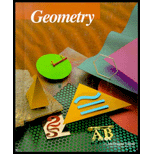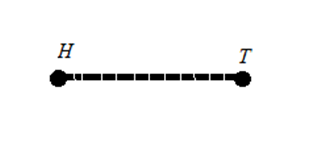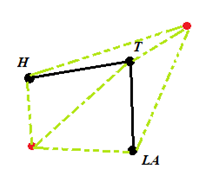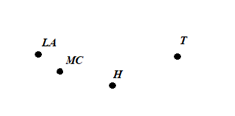
a.
To find how many points are there on Earth’s surface that are equidistant from Houston and Toronto.
a.
Answer to Problem 23WE
Infinitely many points
Explanation of Solution
Given:
Earth
Assume that the Earth is a sphere.
For this case let us consider two points

The points that are equidistant from both these cities would simply be the line segment between these two points
For a sphere two points can be equidistant from an infinitely many number of points.
Conclusion:
Therefore, there are infinitely many number of points that are equidistant from Houston and Toronto.
b.
To find how many points are there on Earth’s surface that are equidistant from Houston, Toronto and Los Angeles.
b.
Answer to Problem 23WE
Two points
Explanation of Solution
Given:
Earth
Assume that the Earth is a sphere.
For this case there are two points

There will only be two points that will be equidistant from all the three cities.
Conclusion:
Therefore, there are two points that are equidistant from Houston, Toronto and Los Angeles.
c.
To find how many points are there on Earth’s surface that are equidistant from Houston, Toronto, Los Angeles, and Mexico City.
c.
Answer to Problem 23WE
No point
Explanation of Solution
Given:
Earth
Assume that the Earth is a sphere.
For this case there are two points

There will be no point that will be equidistant from the 4 points.
Conclusion:
Therefore, there will be no point that will be equidistant from Houston, Toronto, Los Angeles and Mexico City.
Chapter 10 Solutions
McDougal Littell Jurgensen Geometry: Student Edition Geometry
Additional Math Textbook Solutions
College Algebra with Modeling & Visualization (5th Edition)
A First Course in Probability (10th Edition)
A Problem Solving Approach To Mathematics For Elementary School Teachers (13th Edition)
Calculus: Early Transcendentals (2nd Edition)
Introductory Statistics
Pre-Algebra Student Edition
- 2arrow_forwardCan someone help me with this please?arrow_forwardMariela is in her classroom and looking out of a window at a tree, which is 20 feet away. Mariela’s line of sight to the top of the tree creates a 42° angle of elevation, and her line of sight to the base of the tree creates a 31° angle of depression. What is the height of the tree, rounded to the nearest foot? Be sure to show your work to explain how you got your answer.arrow_forward
 Elementary Geometry For College Students, 7eGeometryISBN:9781337614085Author:Alexander, Daniel C.; Koeberlein, Geralyn M.Publisher:Cengage,
Elementary Geometry For College Students, 7eGeometryISBN:9781337614085Author:Alexander, Daniel C.; Koeberlein, Geralyn M.Publisher:Cengage, Elementary Geometry for College StudentsGeometryISBN:9781285195698Author:Daniel C. Alexander, Geralyn M. KoeberleinPublisher:Cengage Learning
Elementary Geometry for College StudentsGeometryISBN:9781285195698Author:Daniel C. Alexander, Geralyn M. KoeberleinPublisher:Cengage Learning

